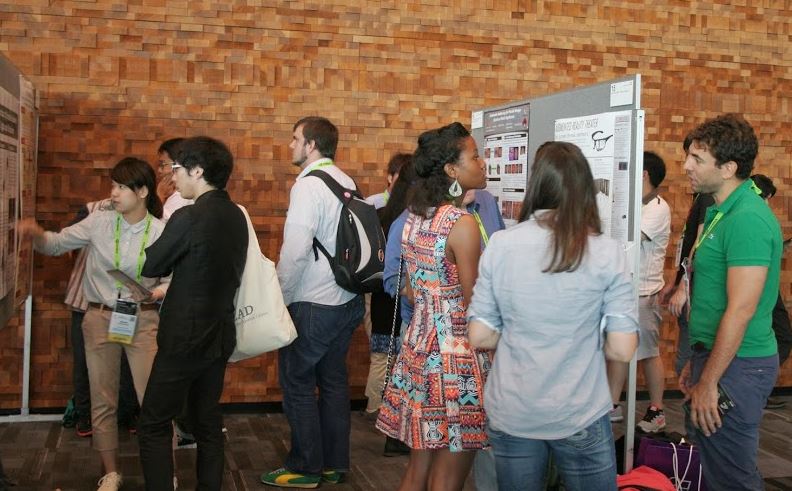One of the core components of ACM SIGGRAPH is its first-class educational support. The community accomplishes this through a variety of avenues. Today we are exploring the Spend a Week at SIGGRAPH Student Program, which focuses on underrepresented groups who otherwise would not have the opportunity to attend SIGGRAPH and learn about its parent organization, ACM SIGGRAPH. The Spend a Week program began in 2003, with the SIGGRAPH Pioneers and the ACM SIGGRAPH Education Committee as its sponsors. The program brings high school sophomores and juniors to the annual SIGGRAPH conference, and exposes them to the latest computer graphics research and hardware. Through the conference’s diverse content, with topics ranging from engineering design to entertainment, the students get a broad perspective of the role that computer graphics play in today’s environment.
The Spend a Week program provides high school students aged 16 or over who live in or near the conference city five days of immersion in the best of computer graphics and interactive techniques. Each student receives a full conference registration and a mentor from the SIGGRAPH community. The SIGGRAPH mentors meet with the students and provide on-site guidance before, during, and after the conference.
In recent years, the program has been supported by the National Science Foundation, GRAND, the NVIDIA Foundation, and conference attendees. Marc Barr, SIGGRAPH 2015 Conference Chair, was recently awarded a multi-year grant by NSF to continue the program.
I have been part of its program since its inception, and throughout the years I have had a variety of experiences. The first year, my student and I met at the Welcome Session, and I never met up with him for the rest of the Conference. We communicated via text and he gave me a daily update of what he and his friends had gone to and why he felt those venues were appropriate for his career. On a different extreme, another year I had breakfast with my student every day because he got dropped off early. We spent the time planning the day, and I spent the majority of the time at the Conference with him. I got to know him and we talked about his dreams and what he was going to accomplish in life, and we are still in touch. He was a determined networker, and he and I both got to meet many people in the community. I got to meet his grandfather, who thanked me for taking care of his grandson, which was immensely gratifying. From both experiences, and all the others within those two extremes, I got to see the awakening of how the program influenced the way the student perceived his/her future. It opened of new avenues, and their perception of the field change as they experienced the Conference.
Comments from other mentors about their takeaways on the program:
Marc Barr, SIGGRAPH 2015 Chair and professor, Middle Tennessee State University. Marc is one of the sponsors of the program and feels the significance of the program is, “The student mentoring program provides local area high school students from underserved and minority groups a great opportunity to see the conference, interact one on one with industry professionals and gain new insights into potential career opportunities.”
Kristy Barkan, ACM SIGGRAPH Content Manager and Project Manager was aware of the mentor program at SIGGRAPH, but never considered volunteering until last year. She said, “For me, the term ‘mentor’ conjures images of a wizened old codger shaking an arthritic finger while dispensing wisdom. When a friend asked me to be a mentor, however, it occurred to me that I’ve been working with computer graphics for more than 20 years, and — despite the lack of an arthritic finger — might have some wisdom to share. I’m so glad I agreed. The experience was hugely rewarding, and well worth the time. In the end, it was my student who taught me, not the other way around. I was able to see SIGGRAPH and the endless possibilities of computer graphics through her fresh eyes, which was an absolute treat.”
Dr William (Bill) J. Joel, professor, Western Connecticut State University and a member of the ACM Education Committee has also been volunteering since the program began. Bill said, “Being a teacher includes far more than simply standing in front of a class and talking your head off. Real teaching occurs in the cracks, when you get a chance to talk one-to-one with a student, and share what it means to be a learner. That’s what it means to be a mentor as well. Not checking off items on a list of topics, but just talking. It’s all about making a connection.”
If you are a parent, teacher, or student, and you think this something you want more information about, please contact the local student recruiter for SIGGRAPH 2015. Student’s don’t need to be directly involved in computer graphics, but he/she must live in or near Los Angeles, which is hosting SIGGRAPH 2015. Teachers help in the selection process, so students must have at least a C average in their academic work. If you are a high school educator who would like to nominate one or more students for this program, please contact the Chief Student Mentor for more information.
This is also a call for mentors, if you are interested in the program and want to volunteer, please fill out the volunteer form on siggraph.org.



